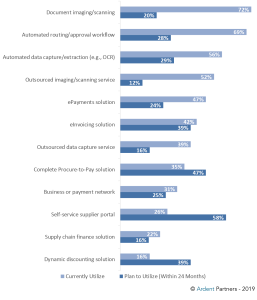[Editor’s Note: Ardent Partners recently published our annual AP-themed report, The State of ePayables 2019: Driving Value in the Age of Intelligence. Today’s article is part of an on-going series focused on the report’s key findings. If you would like to get the full report, it is available for download here (registration required).]
Considering the importance of taking a holistic approach to the transformation of the Accounts Payable function, it is crucial to note that the adoption of core AP systems has been on the rise in recent years. The utilization of more “strategic” forms of automation is widely expected to see bigger adoption numbers in the next decade (see Figure below).

The findings in the Figure above reveal three key truths about the state of AP automation:
- The core tenets of the ePayables Framework are employed by the majority of organizations across the globe (for a refresher on the ePayables Framework, click here). There was a time when solutions such as imaging/scanning (72%), automated approval/routing (69%), and automated data capture/OCR (56%) faced low adoption in the world of AP. Over the past several years, however, organizations have realized the myriad benefits of automating repeatable and menial tasks, helping to drive down invoice-processing costs and shorten approval and payment scheduling times.
- “Extended” automation of the financial value chain is expected to increase into the next decade. Ardent’s research has long pointed to the power of “extended” financial management solutions, such as supply chain finance (22%) and dynamic discounting (16%), in providing additional value to the payment phase of the ePayables Framework. Automating early payment discount capture and strategically (or, “dynamically”) scheduling supplier payment dates can revolutionize the financial value that AP can bring to the greater organization.
- Procurement-based automation has a continued impact on AP. Procurement’s relationship with AP is based on the principles of the P2P process; as such, 35% of businesses today are automating the core tenets of this process in order to drive value across both supply management and financial management. Procure-to-Pay solutions not only make broader supply management capabilities more effective, they also enable more efficiency across the board.
Conclusion
The high automation rates of simple automated solutions like imaging/scanning, and automated data capture/OCR reflect a major victory for the modern AP function. In the past, simple automation was a boon, seen as the light at the end of a very dark tunnel. Today, it represents a crucial stepping stone on its transformation journey from back-office to strategic enterprise function. Although adoption of “extended” automation solutions remains low (which has been the case for the past several years), new research findings point to more businesses leveraging them in the relative, short- term future. Lastly, when AP is well-aligned with procurement from an organizational standpoint, and tightly linked and automated from a process standpoint, they can jointly pursue a series of opportunities to the benefit of the entire enterprise.
If you are interested in a more-detailed breakdown of the results in the Figure above, or want to learn more about the State of ePayables in 2019, download our annual market research report by clicking below.
Related Research:
Download the State of ePayables 2019: Driving Value in the Age of Intelligence Report
The State of ePayables 2019: Intelligence in Action
The “Smart” Way: The Future of ePayables
The State of ePayables 2019: Tactical Automation vs. Strategic Automation







Comments are closed.